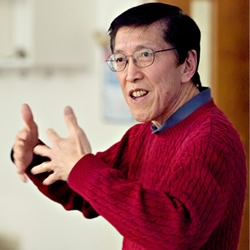Diversity Before Equity?
Educators from all ideological camps want to overcome the nation's gap in educational equity. But can there be equity without diversity? That was a central question pondered at the Winter Symposium hosted in December by the Faculty Executive Committee's Subcommittee on Race, Culture and Diversity. The featured speakers were Derald Wing Sue, Professor of Psychology and Education; Kim Reid, Professor of Education; and Felicia Moore, Assistant Professor of Science Education.
Educators from all ideological camps want to overcome the nation's gap in educational equity. But can there be equity without diversity? That was a central question pondered at the Winter Symposium hosted in December by the Faculty Executive Committee's Subcommittee on Race, Culture and Diversity. The featured speakers were Derald Wing Sue, Professor of Psychology and Education; Kim Reid, Professor of Education; and Felicia Moore, Assistant Professor of Science Education.
Wing Sue's lecture, "Racial Microaggressions as Impediments to Race Relations," focused on the everyday, dismissive snubs toward minorities-'"often performed unconsciously-'"that negatively impact race relations. To Wing Sue, a central reason for these microagressions lies in people's differing perceptions of reality. "Whites' worldview is so predominant that it tends to be invisible to them," he said. "As a result, whites often don't realize how their attitudes affect their individual behavior or the feelings of others."
Microagressions can be expressed in situations as well as conversations, he said. For example, if all the powerful figures in an organization are white, minorities will feel there is a "glass ceiling" that allows them to achieve only a certain level of success. The problem compounds itself, he said, when the majority-'"consciously or unconsciously-'"imposes its view of reality. People become afraid to complain about snubs for fear of being seen as paranoid or oversensitive. Often, their fears are well-grounded.
Reid gave a lecture titled "Dis/Abilities Studies in Education," which portrayed disabled people as another sort of minority-'"America's largest, in fact, comprising more than 55 million people. Race, class and gender are the "holy trinity" of diversity, Reid said, which leaves disability out of the equation. Dis/Abilities Studies is a counter-narrative-'"one that delivers the message that difference is ordinary. She noted that in parts of Africa, having a missing limb is so commonplace that it is not seen as important.
In many ways, she said, disabled persons are excluded in American society more than ever before. After World War II, the employment rate for disabled persons was 97 percent. Today, it-'s 37 percent. Disabled people have been "ghettoized" by programs such as the Board of Cooperative Educational Services, Reid says, which clumps them together and out of the way of the majority. What's the solution? For Reid, disability should be reconceived as a class of social oppression rather than medicalized as a condition, and all children should be educated together.
Moore, who said that her preservice education students at TC often are anxious about their inexperience working in diverse classrooms, titled her talk "Is this TOO Diverse to Handle?"
"Understanding race, culture and diversity is not just a cognitive issue. It has to come from experiential reality," she said, adding that reality often reveals the limits of the diversity conversation in America. Moore's case in point: her own recent attendance at a conference on diversity at which she was the only black person.
Published Thursday, Feb. 23, 2006
